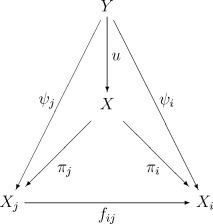 | ||
In mathematics, the inverse limit (also called the projective limit or limit) is a construction that allows one to "glue together" several related objects, the precise manner of the gluing process being specified by morphisms between the objects. Inverse limits can be defined in any category.
Contents
Algebraic objects
We start with the definition of an inverse system (or projective system) of groups and homomorphisms. Let (I, ≤) be a directed poset (not all authors require I to be directed). Let (Ai)i∈I be a family of groups and suppose we have a family of homomorphisms fij: Aj → Ai for all i ≤ j (note the order), called bonding maps, with the following properties:
- fii is the identity on Ai,
- fik = fij o fjk for all i ≤ j ≤ k.
Then the pair ((Ai)i∈I, (fij)i≤ j∈I) is called an inverse system of groups and morphisms over I, and the morphisms fij are called the transition morphisms of the system.
We define the inverse limit of the inverse system ((Ai)i∈I, (fij)i≤ j∈I) as a particular subgroup of the direct product of the Ai's:
The inverse limit, A, comes equipped with natural projections πi: A → Ai which pick out the ith component of the direct product for each i in I. The inverse limit and the natural projections satisfy a universal property described in the next section.
This same construction may be carried out if the Ai's are sets, semigroups, topological spaces, rings, modules (over a fixed ring), algebras (over a fixed ring), etc., and the homomorphisms are morphisms in the corresponding category. The inverse limit will also belong to that category.
General definition
The inverse limit can be defined abstractly in an arbitrary category by means of a universal property. Let (Xi, fij) be an inverse system of objects and morphisms in a category C (same definition as above). The inverse limit of this system is an object X in C together with morphisms πi: X → Xi (called projections) satisfying πi = fij o πj for all i ≤ j. The pair (X, πi) must be universal in the sense that for any other such pair (Y, ψi) (i.e. ψi: Y → Xi with ψi = fij o ψj for all i ≤ j) there exists a unique morphism u: Y → X such that the diagram
commutes for all i ≤ j, for which it suffices to show that ψi = πi o u for all i. The inverse limit is often denoted
with the inverse system (Xi, fij) being understood.
In some categories, the inverse limit does not exist. If it does, however, it is unique in a strong sense: given any other inverse limit X′ there exists a unique isomorphism X′ → X commuting with the projection maps.
We note that an inverse system in a category C admits an alternative description in terms of functors. Any partially ordered set I can be considered as a small category where the morphisms consist of arrows i → j if and only if i ≤ j. An inverse system is then just a contravariant functor I → C. And the inverse limit functor
Examples
Derived functors of the inverse limit
For an abelian category C, the inverse limit functor
is left exact. If I is ordered (not simply partially ordered) and countable, and C is the category Ab of abelian groups, the Mittag-Leffler condition is a condition on the transition morphisms fij that ensures the exactness of
(pronounced "lim one") such that if (Ai, fij), (Bi, gij), and (Ci, hij) are three projective systems of abelian groups, and
is a short exact sequence of inverse systems, then
is an exact sequence in Ab.
Mittag-Leffler condition
If the ranges of the morphisms of an inverse system of abelian groups (Ai, fij) are stationary, that is, for every k there exists j ≥ k such that for all i ≥ j :
The name "Mittag-Leffler" for this condition was given by Bourbaki in their chapter on uniform structures for a similar result about inverse limits of complete Hausdorff uniform spaces. Mittag-Leffler used a similar argument in the proof of Mittag-Leffler's theorem.
The following situations are examples where the Mittag-Leffler condition is satisfied:
An example where
where Zp denotes the p-adic integers.
Further results
More generally, if C is an arbitrary abelian category that has enough injectives, then so does CI, and the right derived functors of the inverse limit functor can thus be defined. The nth right derived functor is denoted
In the case where C satisfies Grothendieck's axiom (AB4*), Jan-Erik Roos generalized the functor lim1 on AbI to series of functors limn such that
It was thought for almost 40 years that Roos had proved (in Sur les foncteurs dérivés de lim. Applications. ) that lim1 Ai = 0 for (Ai, fij) an inverse system with surjective transition morphisms and I the set of non-negative integers (such inverse systems are often called "Mittag-Leffler sequences"). However, in 2002, Amnon Neeman and Pierre Deligne constructed an example of such a system in a category satisfying (AB4) (in addition to (AB4*)) with lim1 Ai ≠ 0. Roos has since shown (in "Derived functors of inverse limits revisited") that his result is correct if C has a set of generators (in addition to satisfying (AB3) and (AB4*)).
Barry Mitchell has shown (in "The cohomological dimension of a directed set") that if I has cardinality
Related concepts and generalizations
The categorical dual of an inverse limit is a direct limit (or inductive limit). More general concepts are the limits and colimits of category theory. The terminology is somewhat confusing: inverse limits are limits, while direct limits are colimits.
